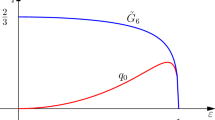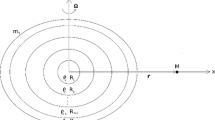Abstract
A closed-form expression is obtained for the density of a simple layer, equipotential to an oblate level ellipsoid of revolution in an outer space. The potential of any level spheroid of positive mass with the inward direction of the attracting force on its surface can be represented in this way. A family of density functions defined within the whole volume of a level ellipsoid of revolution is found. Several density examples are considered.




Similar content being viewed by others
Data Availability Statement
Data sharing not applicable to this article as no datasets were generated or analyzed during the current study.
References
Antonov, V.A., Timoshkova, E.I., Kholshevnikov, K.V.: Introduction to the Theory of Newtonian Potential. Nauka, Moscow (1988) (in Russian)
Hofmann-Wellenhof, B., Moritz, H.: Physical Geodesy. Springer (2006)
Kholshevnikov, K.V., Milanov, D.V., Shaidulin, V.S.: The Laplace series of ellipsoidal figures of revolution. Vestnik St. Petersb. Univ. Math. 50, 406–413 (2017). https://doi.org/10.3103/S1063454117040112
Kholshevnikov, K.V., Milanov, D.V., Shaidulin, V.S.: Laplace series for the level ellipsoid of revolution. Celest. Mech. Dyn. Astr. 130, 64 (2018). https://doi.org/10.1007/s10569-018-9851-7
Kondratiev, B.P.: Theory of Potential, and Figures of Equilibrium. Inst. Kosm. Res., Moscow (2003) (in Russian)
Korn, G.A., Korn, T.M.: Mathematical Handbook for Scientists and Engineers: Definitions, Theorems, and Formulas for Reference and Review. McGraw-Hill (1968)
Pizzetti, P.: Principii Della Teoria Meccanica Della Figura dei Pianeti. E. Spoerri, Pisa (1913)
Acknowledgements
The author will be forever grateful to Professor Konstantin V. Kholshevnikov (1939–2021), who pointed him the direction of this research and gave a lot of invaluable advices. The author also thanks Professor Luis Floría for the careful review of the article and numerous useful remarks.
Author information
Authors and Affiliations
Corresponding author
Ethics declarations
Conflict of interest
We declare that we do not have any commercial or associative interest that represents a conflict of interest in connection with the paper submitted.
Additional information
Publisher's Note
Springer Nature remains neutral with regard to jurisdictional claims in published maps and institutional affiliations.
Appendix
Appendix
The function \(H(\varepsilon )\) defined by (19) decreases on the interval [0, 1]. Let us express the dependence of H on \(\varepsilon \) explicitly and make sure that its derivative is negative,
Let us expand the square root and the arcsine into series up to the fourth degree of \(\varepsilon ^2\):
The maximum of the quadratic trinomial in the last expression is attained at \(\varepsilon =1\) and equals \(-2657/6720\).
Rights and permissions
About this article
Cite this article
Milanov, D.V. Representation of the gravitational potential of a level ellipsoid by a simple layer. Celest Mech Dyn Astron 134, 26 (2022). https://doi.org/10.1007/s10569-022-10086-4
Received:
Revised:
Accepted:
Published:
DOI: https://doi.org/10.1007/s10569-022-10086-4




